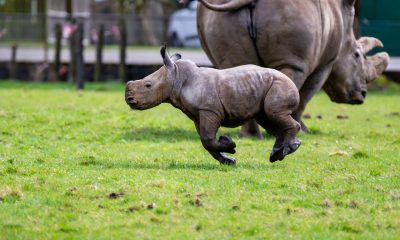Scientists warn over 850 species could be wiped out if humans continue to do this
But a focus on urban planning that protects habitats can mitigate the impact, say scientists.
Published
2 years ago onBy
Talker News
By Stephen Beech via SWNS
More than 850 species could be wiped out by the growth of towns and cities around the world over the next 30 years, according to a new study.
Researchers warned that a projected urban expansion of more than 500,000 square miles over the next three decades threatens the survival of hundreds of breeds of birds and animals.
But a focus on urban planning that protects habitats can mitigate the impact, say scientists.
The global urban population is projected to increase by 2.5 billion people over the next 30 years, which will greatly increase the spread of towns and cities.
Much of the forecast urban expansion is predicted to occur in biodiversity hotspots — areas rich with species that are at a high risk of destruction due to human activity..
Expansion is projected to result in up to 1.53 million square kilometers (590 square miles) of new urbanized land, directly threatening 855 species, according to the findings of the study published in the journal Proceedings of the National Academy of Sciences (PNAS).
The study identified "hotspot" cities whose growth are predicted to have particularly large impacts on species habitats. Many of the cities are in equatorial regions where urban growth coincides with biodiverse habitats.
The cities that pose the greatest threat to species due to expansion are predominately located in the developing tropical regions of sub-Saharan Africa, South America, Mesoamerica, and Southeast Asia.
Species listed as “threatened” on the International Union for Conservation of Nature’s Red List are disproportionately represented among those most heavily impacted, according to the findings.
But focusing global efforts on minimizing impacts on habitats in these growth regions can help conserve and protect species, say the research team led by scientists from Yale University in the US.
The study relied on data from Yale's Map of Life - a collection of species distribution data used to monitor, research, and create policies that protect species worldwide.
It also used a recently developed suite of land-use projections to assess future habitat loss from urban land expansion for more than 30,000 terrestrial species globally. The study found that urban land expansion is a significant driver of habitat loss for about one-third of these.
The study comes as the 15th Conference of Parties to the UN Convention on Biological Diversity prepares to convene next month to decide the new post-2020 biodiversity conservation framework.
Co-author Professor Karen Seto, of Yale School of the Environment (YSE), said: “Cities are actually part of the solution.
“We can build cities differently than we have in the past. They can be good for the planet; they can save species; they can be biodiversity hubs and save land for nature.’’
The study found that the largest impacts on species are not from the world’s largest cities, but from urban areas that have a myriad of endemic species and where expansion can destroy habitats. And these areas are rapidly becoming more urbanized.
Study lead author Rohan Simkin, a Ph.D. student at YSE, said: “One of the aims of the study was to identify those species, not that just are threatened, but that are specifically threatened by urban land development.
“I think that the average person on the street is very aware of the climate crisis now, but I’m not sure they are aware of the biodiversity crisis.”
But obstacles to containing sprawl include economic pressures, governance structures, and awareness of the importance of habitats and preserving biodiversity. It’s easier to build out, not up, noted Prof. Seto.
Species under the most pressure from expansion are concentrated in areas from central Mexico through Central America, the Caribbean, Haiti, Nigeria, Cameroon, Sri Lanka, Indonesia, Malaysia, Thailand, Brazil, and Ecuador.
Robert McDonald, lead scientist for nature-based solutions at The Nature Conservancy, said: “We are at a critical moment when the world’s governments are renegotiating their commitments to the Convention on Biological Diversity.
"This study is important since it lets us quantify, for the first time, which specific species are most threatened by urban growth and where urban protected areas are needed to safeguard them."
Professor Walter Jetz, director of the Yale Centre for Biodiversity and Global Change, said: “The study offers vital decision-support in regions across the world to plan for urban growth that minimizes the loss of biodiversity.
“It leverages the Species Habitat Index, a central biodiversity change indicator of the draft post-2020 Global Biodiversity Framework of the Convention on Biological Diversity, to assess future scenarios.”
Despite the potential for loss of species from land expansion, Prof. Seto says the study highlights how cities can proactively protect biodiversity.
She added: “The majority of these places have yet to be built.
“Science-driven policies that guide how the cities of tomorrow get built will have a tremendous effect.”
Stories and infographics by ‘Talker Research’ are available to download & ready to use. Stories and videos by ‘Talker News’ are managed by SWNS. To license content for editorial or commercial use and to see the full scope of SWNS content, please email [email protected] or submit an inquiry via our contact form.
You may like


Giant prehistoric salmon used tusk-like teeth to fight off predators


Evidence of Earth’s magnetic field dates back 3.7 billion years


New research reveals early galaxies evolved much faster than thought


Majority of American moms and dads feel lonely and burned out


Hospital patients treated by women doctors are less likely to die


Majority of parents ‘customize’ meals for picky kids
Other Stories


Pro mermaid’s career goes swimmingly after overcoming ocean fear
She makes up to $8,000 a show.


Giant prehistoric salmon used tusk-like teeth to fight off predators
The species that grew up to nine feet long lived in the North American Pacific Northwest.


Evidence of Earth’s magnetic field dates back 3.7 billion years
Life on Earth would not be possible without its magnetic field.


Adorable video shows baby rhino enjoying sunshine
By Faye Mayern via SWNS An endangered baby rhino has well and truly found its feet after being filmed playing...


Hilarious moment delivery man gets chased by tiny dog
The hilarious encounter was caught on video.
Top Talkers

 Parenting6 days ago
Parenting6 days agoSingle mom details struggles of feeding her 12 kids

 Lifestyle5 days ago
Lifestyle5 days agoWoman regrets her tattoo nightmare: ‘It’s horrendous’

 Good News2 days ago
Good News2 days agoDisabled student takes first steps in 10 years on graduation stage

 Broadcast1 week ago
Broadcast1 week agoOver 40% of Americans have no clue what a 401k is

 Broadcast1 week ago
Broadcast1 week agoHow hard is it for Americans to live sustainably?

 Health2 days ago
Health2 days agoNew study reveals ‘old age’ begins later than it used to

 Money1 week ago
Money1 week agoOver 40% of Americans have no clue what a 401k is

 Environment1 week ago
Environment1 week agoHow hard is it for Americans to live sustainably?
